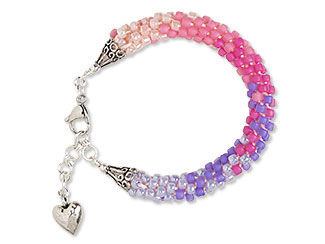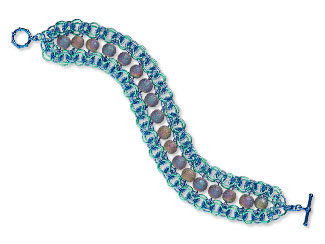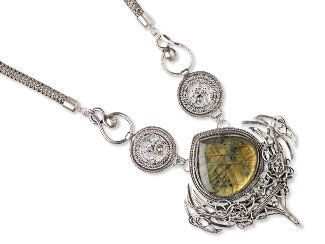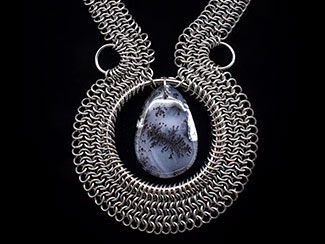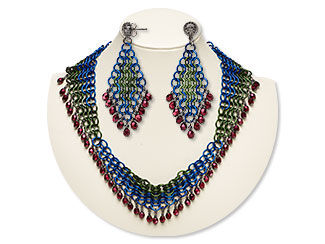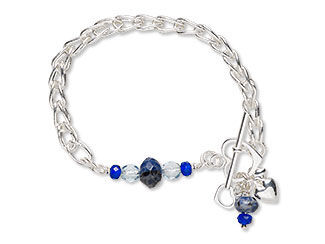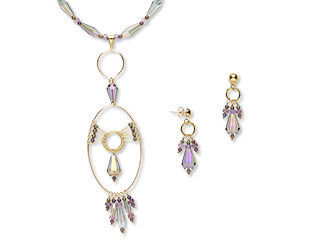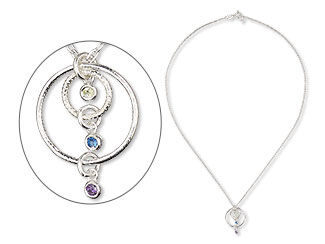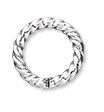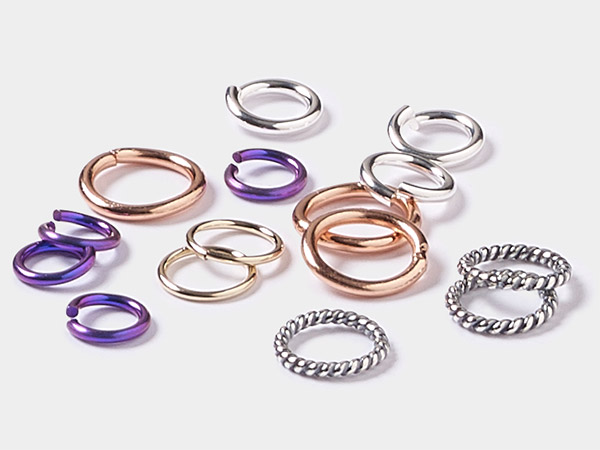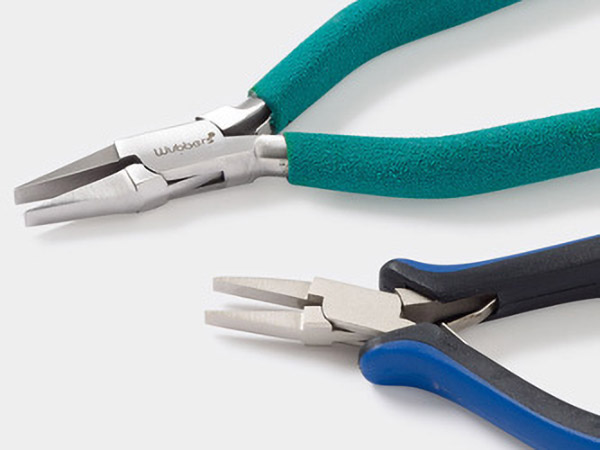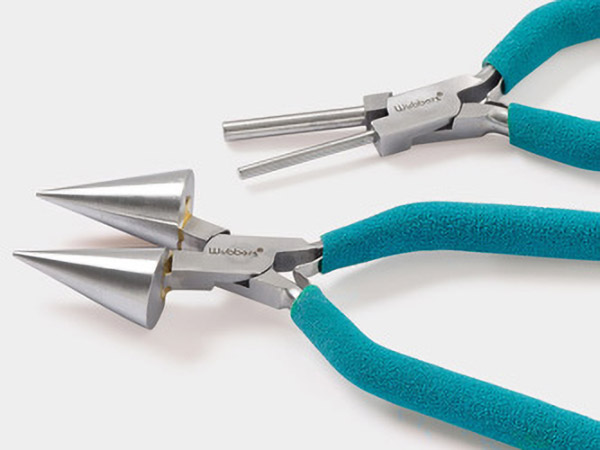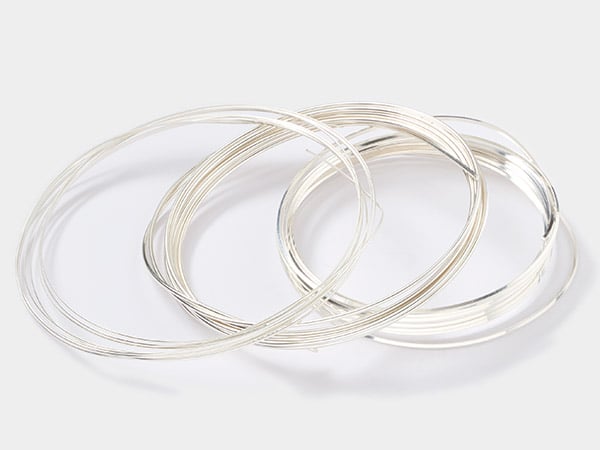All About Jump Rings
Jump rings are an essential finding for jewelry designers. These handy little components can seem a little overwhelming at first with the myriad of uses, materials, sizes and other options to consider. We're here to break it all down for you and get you fully prepared to design with jump rings.
Jump Rings—The Basics
Jump rings are formed from a coil of wire. The coil is cut apart and the rings are formed with a slit where the ends of the circle meet. The most typical use for jump rings is a connection. This includes simply linking a clasp to the rest of your design, a charm to a chain bracelet and other basic links.
There are recommended ways to open and close jump rings—and specific tools designed for jump rings. Jewelry maker Tammy Honaman shares how to open and close a jump ring in this quick video how-to:

Jump Rings—Tools of the Trade
You'll want to know about some tools that will make using jump rings easy. Typically, you'll need a set of chain-nose and flat-nose pliers when working with or opening and closing jump rings.
If you have a lot of jump rings, such as for chainmaille, the jump ring tool slides comfortably onto your finger and makes quick work of opening and closing. To see both of these techniques demonstrated in proper form, see our ''Opening a Jump Ring'' how-to video and illustrated instructions or the ''Secrets to Opening and Closing Jump Rings'' how-to video.

Curved chain-nose pliers, also called bent-nose pliers, are handy for getting into tight spots while still being able to see. Specific loop-closing pliers help ensure jump rings, bracelet links and other connections are fully closed.
When manipulating jump rings, especially precious metals, there is a chance of marring your metal. To protect against this, nylon jaw pliers are designed to prevent nicks or color chipping on wire. If the nylon-jaw pliers don't quite work for your application, Tool Magic® coats the metal jaws on pliers with a heavy-duty, latex-free rubber. This enables you to work with wire, jump rings and other metals without causing injury to finishes, platings, color or sensitive precious metals.
Jump Rings—Chainmaille
Jump rings are excellent as connection points, but their versatility is not limited to them. These little rings have been used in chainmaille throughout the ages and all around the world. These chainmaille pieces were for necessity rather than fashion and helped protect the wearer from harmful situations. Today though, chainmaille jewelry is known as being a brilliant use of these ancient techniques and the resulting style is highly sought after.
Some examples include:
And many more! Plus hybrids of chainmaille weaves provide new twists on old favorites. View the chainmaille resources on our website to learn how to create these and other chainmaille weaves.
Jump Rings—Non-Traditional Uses
We've covered basic connections and chainmaille weaves, yet there are some not-so-basic applications as well, including use as spacers and for creating links of new chains.
See full instructions on how to manipulate jump rings to form custom links and make more than a basic chain with jump rings in this exclusive tutorial: ''How to Create a Loop in Loop Chain''.
Jump Rings—Measurement
Now the question arises: how do you know which size jump rings to buy for which project? Jump rings range from tiny to huge and are measured by diameter. There is an outside diameter (OD) and an inside diameter (ID). Sometimes, certain chainmaille weaves will require a particular diameter or combination of diameters (like in helm chain or dragonscale) to ensure all the interlocking pieces fit as they should.
Gauge is another measurement, telling how thick the jump ring is, which has effects on the weight and pressure the jump ring can bear in a design.
At times, you may only know the OD, but you need to know the ID. There is a simple formula to find one diameter, using the other. All measurements need to be in millimeters before using the below equation. First, you'll need to find the wire gauge of the jump ring and convert that into millimeters using our handy conversion chart. If you don't already know the gauge, the easiest way to measure this is using a caliper. If you have no calipers on hand, measure in millimeters with a ruler.
OD = ID + (Gauge x 2)
To find the outside diameter, multiply the gauge by 2, and then add the inside diameter.
ID = OD - (Gauge x 2)
To find the inside diameter, multiply the gauge by 2, and then subtract that amount from the outside diameter.
Note: Fire Mountain Gems and Beads' product descriptions provide American Wire Gauge (AWG) measurements. There are multiple gauge measurement systems, so check your design requirments.
Jump Rings—Materials
You know how to find the right size, so it's time to find the right material—and you have a lot of materials to choose from. Traditionally, jump rings are made from metal, but have branched out into other fun variations.
Metals:
Metal jump rings are available in smooth and some twisted versions, as well as closed or open options. A soldered, or closed, jump ring is a solid ring of metal. Closed jump rings are often used at connection points where a little extra security is preferred. These soldered jump rings cannot be opened with pliers unless first cut open with flush-cutters or a jeweler's saw. Open jump rings have a seam you can open.
Colorful niobium and aluminum add vibrant pops of color. Learn more about each metal type of jump ring in these videos with Tammy Honaman.
In addition, Loop Lock™ findings take inspiration from riveted chainmaille. They are an open jump that can be turned into a closed jump ring and "lock" into place with a pair of pliers. Loop Lock findings are available in sterling silver, brass and pewter. Here's how to use Loop Locks.
Other Materials:
Other ring-shaped materials are popular additions to use with jump rings, especially in chainmaille designs: metal, gemstone, wood and acrylic donuts; colorful Czech pressed glass rondelle rings; and flexible Oh! Rings. All are fully closed rings and can be used as spacers as well as ring components. Rigid materials add color and texture. Soft materials are handy for more malleable designs that are easy to put on and take off.
For more information about Czech pressed glass beads, read ''The History of Preciosa Czech Glass Bead Making''. For more information about Oh! Rings, take a look at our explanatory article ''Life in Color: Oh! Ring™ Components''.
Jump Rings—Shapes
While round is the most common shape, jump rings are made—and manipulated—into multiple options. Oval jump rings are the popular choice for our in-house jewelry designers to use for finishing strung designs. With oval jump rings, the seam is in the middle of the long side of the oval—not at the ends where the most pressure occurs whenever a piece is worn.
Beyond functional choices, accenting designs with a different-shaped jump ring breathes new life into connection possibilities. Designers also have a choice of jump rings made from round wire, square wire, diamond wire, twisted wire, twisted square wire and twisted diamond wire. These textures add visual interest to jewelry designs, with a little subtle flash.
Jump Rings—Make Your Own
When you need a certain size or shape of jump ring—or you just want to make some of your own—there are a couple ways to go about it. If you're in the business of jump rings, it may just end up saving you money, too. Here's how to make your own jump rings:
1. Select your wire. Half-hard wire is strongly recommended since dead-soft may not hold shape well and full-hard is difficult to coil.
2. Wrap your wire according to the method you prefer, whether you're coiling on mandrels, mandrel pliers or other tools.
- ''Making Jump Rings with Jump Ring Mandrels'' how-to video
- ''How to Use a Jump Ring Maker'' how-to video and illustrated instructions
3. Cut through the coils with flush-cutters or a jeweler's saw. Sometimes holding your coiled wire in a table vise or the EUROTOOL® coil-cutting pliers is handy for keeping wire in place while cutting.
Jump rings are a traditional connector, a component for chainmaille, an element for making custom chain and much more. Now that you know more about jump rings, you can explore the creative possibilities of these handy little findings.
Shop for Your Materials Here:
Have a question regarding this project? Email Customer Service.
Copyright Permissions
All works of authorship (articles, videos, tutorials and other creative works) are from the Fire Mountain Gems and Beads® Collection, and permission to copy is granted for non-commercial educational purposes only. All other reproduction requires written permission. For more information, please email copyrightpermission@firemtn.com.


